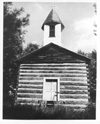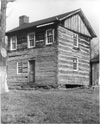Log Buildings 1638 - 1880
History
Few historic buildings have caught the public imagination as much as log houses have. To many people, these simply designed structures are the epitome of early American life, and thus the log house has assumed a rather mythic and romanticized place in our national history. However, log buildings played a real and significant part in Pennsylvania's architectural past.
The Swedes, who settled in southeastern Pennsylvania in the mid-17th century, are credited with first bringing the log house form to the American colonies. The Swedes had established several permanent settlements as part of the colony of New Sweden in southeast Pennsylvania and Delaware from 1638 through 1654. Despite some challenges by the Dutch, the Swedes and Finns of New Sweden continued to control their land until William Penn claimed the land under his charter for Pennsylvania in 1682. The few remaining Swedish log buildings in the southeast corner of the state are the earliest evidence of European settlement in Pennsylvania . The earliest surviving building in our state is the Lower Swedish Cabin, which dates from circa 1640 and is located along the Darby Creek in Drexel Hill , Delaware County. The Lower Swedish Cabin is a typical Swedish log house, built from hewn logs, stacked horizontally and joined by notched ends with a corner chimney. Clay chinking fills the space between the logs. Almost all the buildings in New Sweden were of log construction: houses, barns, churches, forts, mills, sheds, stables, and trading posts. Even the house of the governor of the colony was made of logs. Unfortunately, just a few of these early Swedish log buildings survive.
Another early survivor is Morton Homestead in Prospect Park , Delaware County. It is a one and one half story three-room house, built in three periods. The earliest section of the house dates to circa 1698; a similarly-designed log addition was made in 1758, and a stone connecting center section dates from the late 18th century. Log construction was not just for houses; it was used for forts, taverns, barns, churches and mills.
The log building form was adopted from the Swedish by other settlers in Pennsylvania . When the English, Irish, and Welsh settlers arrived with William Penn, constructing a log house was an expedient way to provide shelter in the new world. Oftentimes a log house was built, only to be replaced as fortunes improved, with a house of brick or stone. The log houses were then abandoned or relegated to use as a shed or agricultural outbuilding or housing for relatives. Log houses were also incorporated into newly expanded buildings as seen in the Morten Homestead. Log buildings were constructed by the German and Scots-Irish settlers as settlement moved westward. While the Swedish preferred corner chimneys, the Germans generally built central chimneys, and the English often used wall end chimneys. Log buildings were usually of one or two story design, with some beginning as a single story, and then enlarged. Windows were small, originally employing sliding wood shutters before glass was commonly available. The gable ends were made of boards and the roofs of wooden shingles.
Vernacular architectural historians have identified a number of traditional log house forms and patterns commonly found in the United States. A simple, one-room, log house is called as a single pen or single crib house. Another common descriptive term for log houses in the Mid-Atlantic region is a Continetal Plan house, made up of a single-pen log house with three rooms arranged around a center fireplace. The Continental Plan type of log house is associated with the early German settlers of Pennsylvania who brought this building tradition with them from Europe. Another common log building plan is the Saddlebag Plan, where two single-pen log rooms are joined by a center chimney. The Saddlebag Plan often reflects the addition of another log room onto an earlier building with the old exterior chimney wall now forming a center interior one. The Dogtrot Plan includes two log pens with an open porch or covered passageway between. The Dogtrot Plan is often associated with the building traditions of the southern states because its open air design is well suited for warm weather.
In the mid to late 19th century, log buildings were often covered by clapboards in an effort to make these vernacular buildings fit into the architectural styles of the day. Many historic buildings thus have an inner core of logs, long covered and forgotten. Due to the immense practicality of log construction, log buildings continued to be built throughout the 19th century, especially in more remote areas of the state. Log construction also remained popular for sheds and agricultural buildings.
Certain types of late 19th and early 20th century buildings incorporate log construction to create a consciously "rustic" design. In the 1870s as part of the "Great Camp Movement" rustically designed vaction homes and visitor lodges were built in the Adierondack Mountains of New York. Buildings of similar style and design were also constructed in the Poconos area of Pennsylvania as rustic retreats. Designed with natural materials to better fit into their wooded enviroment, these buildings featured native stone, wood shingles, and logs, often with the bark retained. In the 1930s and 1940s the Civilian Conservation Corps (a federal program created as part of FDR's New Deal) also produced log buildings for public parks. These early 20th century log cabins, visitor centers and support buildings are still present in Pennsylvania's public parks and recreation areas. Thus, every log building should not be assumed to be of especially early construction.
Common Building Types
- houses
- barns
- forts
- taverns
- churches
- mills
Identifiable Features
- Horizontal log construction
- Small windows
- Clay or mud chinking between logs
- Side gabled roof
- Brick, stone or clay chimneys
- Irregular spaced window and door openings
Photos
Click the thumbnails for larger images.




